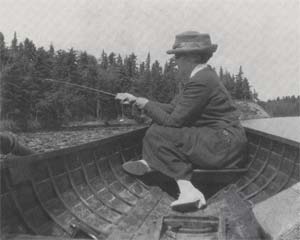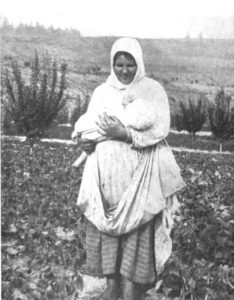By Emily Clark
Long before the term “photojournalist” came into fashion in the late 1930s, one Connecticut native made her living in this career field, telling stories through her photographs. Traveling throughout North America with her camera bag, Edith S. Watson became known as the “camera artist.”
Finding a Passion
Born in 1861 to Sarah and Reed Watson, the photographer grew up on a tobacco farm in rural East Windsor Hill. As a child, Watson loved art and her parents encouraged her and her siblings to seek careers in fields they enjoyed while also remaining financially independent. In her late teens, she left home with just her family’s donkey and a few dollars to explore Connecticut and Massachusetts, painting the communities and environments she traveled through. Upon returning home, she continued to pursue her love of art, first as a watercolorist (establishing a studio with her older sister Amelia), and then as a photography student at Harvard University in the early 1890s.
Photographing Rural Canada
Watson did not remain in New England for long, however. In 1896, she made her first excursion into Canada, starting in Newfoundland and Labrador, traveling by boat to coastal communities such as Fortune Harbour and Twillingate. Watson captured the rural countryside through her photographs, which she sold to newspapers and magazines including The New York Times, the Toronto Star, and the Newfoundland Quarterly—earning enough to support herself and purchase supplies. Enjoying her freedom as well as her success in Canada, the new photojournalist became known as “Miss Edith Watson, the camera artist.”
While Watson originally earned fame for her landscape photography, her talent is best displayed in the portraits she created, primarily in Canada. Her images, mostly of women and girls, reveal the routine of daily life and its grueling tasks of hoeing potatoes, caring for children, hauling water, and making soap. Such photographs show a reality that had never been documented and established Watson as a professional in this field. Early in her career, she insisted on receiving a credit line for her work, even before it was common to do so, and created her own photographer’s stamp: “Edith S. Watson.” Over time, travel guides also published her photographs to highlight tourist destinations in both Canada and the United States.
Companionship and Publication
In addition to living and working on the Eastern Seaboard throughout the milder months, Watson spent winters with her family in Connecticut and then Bermuda where she rented a cottage and continued to sell her art. It was there in 1911 that she met journalist Victoria Hayward. For the next 30 years, these women collaborated and traveled together—partners in both life and work. As they journeyed throughout remote areas of Canada, Hayward wrote articles to compliment Watson’s photographs; they published a book, Romantic Canada, in 1922. In the book, Hayward created the expression “Canadian Mosaic” to describe the multicultural nature of the rural country—a term still in use today.
They often worked in remote areas, so Watson developed her photographs in streams, in people’s kitchen sinks, or at water pumps. At times, money was scarce, but Watson persevered as a freelancer, committed to succeeding in the occupation that was her passion.
Her Legacy: “Honest Depictions of Ordinary Women”
Despite the success Watson earned in the early 20th century, people know her photographs today largely due to the interest and research of Canadian author Frances Rooney, who published several books of Watson’s photography, including Working the Rock and Working Light. Rooney writes about how realistically Watson captured everyday life in rural and coastal locales. According to Rooney, these “honest depictions of ordinary women were almost invisible…The perils of being a woman living in Newfoundland have received almost no attention…[They] shine as independent, resourceful, and exceptional.”
While on a trip to Florida in December 1943, Edith Watson died at the age of 83. Over the five decades she traveled around North America, Watson’s keen eye and box camera lens captured the otherwise untold stories of women, providing a unique perspective on the humblest of lives.
Emily Clark is a freelance writer and an English and Journalism teacher at Amity Regional High School in Woodbridge.












